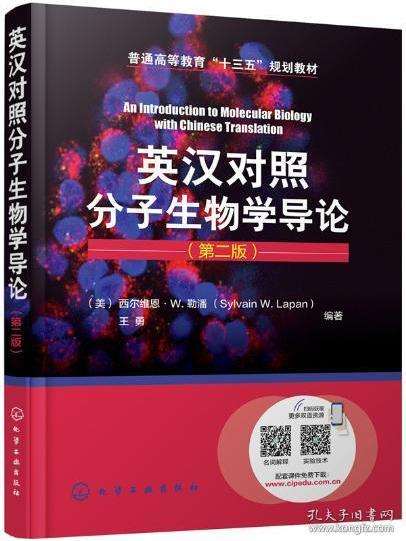《英漢對照分子生物學導論(第二版)》是2008年1月1日由化學工業出版社出版的圖書,作者是(美國)西爾維恩W·勒潘和王勇。
基本介紹
- 中文名:英漢對照分子生物學導論(第二版)
- 作者:(美)西爾維恩·W.勒潘(Sylvain W. Lapan)、王勇
- 出版社:化學工業出版社
- 出版時間:2018年11月
- 頁數:257 頁
- 開本:16K 787×1092 1/16
- 裝幀:平
- ISBN:978-7-122-32528-0
內容簡介,目錄,
內容簡介
本書是為分子生物學雙語教學而編寫,適用於高年級本科學生使用。本書內容涵蓋分子生物學的中心問題,即DNA複製、轉錄、翻譯和重組。我們從該領域的最基本內容(生物大分子的結構與功能)開始,系統、完整地闡述了上述主題,並引領讀者貫通現代知識體系,從而深入理解這些過程是如何進行調控並創造出我們稱之為“生命”的動態系統的。我們有目的地使用簡潔的語言和詳盡的插圖來強化雙語教學。書中通過嵌入二維碼的方式配備了全文各章節英語課文、單詞表音頻錄音,以及英漢對照名詞解釋,由此進一步強化雙語教學目標。二維碼內容還包含一些重要的實驗技術雙語內容,可以幫助學生將課堂所學分子生物學知識與課外學習活動聯繫起來。通過提供關於分子生物學重要內容和相關領域專業英語方面的訓練,本教材能真正為讀者提供一種現代的、切合實際的學習方式。
目錄
Introduction
Chapter 1 Amino Acids to Proteins
1.1Protein Composition
1.2Protein Conformations
1.2.1Describing Protein Structure
1.2.2Chemical and Physical Basis for Protein Folding
1.3Protein Structure and Function:A Few Examples
1.4The Dynamics of Proteins
1.5Experiments
Summary
Vocabulary
Review Questions
Exploration Questions
Chapter 2 Nucleic Acids
2.1Properties of a Genetic Material
2.2Nucleic Acids and DNA structure
2.2.1Nucleotides
2.2.2General Structure of Nucleic Acids
2.2.3Structure of DNA
2.3DNA as the Genetic Material
2.4DNA in the Cell
2.5RNA (Ribonucleic Acid)
2.6Experiments
Summary
Vocabulary
Review Questions
Exploration Questions
Chapter 3 Transcription in Prokaryotes:Mechanism and Regulation
3.1Why Use an RNA Intermediate
3.2Mechanism of Transcription
3.2.1Promoters
3.2.2RNA Polymerase
3.2.3Transcription Mechanism in Three Phases
3.3Regulation of Gene Expression in Prokaryotes
3.3.1Coordinate Regulation
3.3.2The Lac Operon
3.3.3The Trp Operon
3.3.4Ara and Gal Operons
3.4Experiments
Summary
Vocabulary
Review Questions
Exploration Questions
Chapter 4 Transcription in Eukaryotes:Mechanism and Regulation
4.1Eukaryotic RNA Polymerases
4.2Eukaryotic Promoters
4.3General Transcription Factors and Initiation
4.3.1TFⅡD
4.3.2Other TFⅡs
4.3.3General Transcription Factors for RNA Polymerase Ⅰand Ⅲ
4.4Specific Transcription Factors and Transcriptional Regulation
4.4.1Activators
4.4.2Repressors
4.4.3Enhancers and Silencers
4.5Structures of Specific Transcription Factors
4.5.1DNA-Binding Motifs in Prokaryotes
4.5.2DNA-Binding Motifs in Eukaryotes
4.6Experiments
4.6.1RNA Polymerase Targets
4.6.2Modularity of Specific Transcription Factors
Vocabulary
Review Questions
Exploration Questions
Chapter 5 mRNA Modifications in Eukaryotes
5.1Capping
5.2Polyadenylation
5.3Splicing
5.3.1The Basic Splicing Reaction
5.3.2Proteins Involved in Splicing
5.3.3Self-Splicing
5.3.4Trans-Splicing
5.3.5Reasons for Introns
5.4mRNA Editing
5.5Experiments
Summary
Vocabulary
Review Questions
Exploration Questions
Chapter 6 Translation
6.1The Genetic Code
6.2Mechanism of Translation in Prokaryotes
6.2.1Initiation
6.2.2Elongation
6.2.3Termination
6.3Translation in Eukaryotes
6.4tRNA Structure and Wobble
6.4.1Anti-codons
6.4.2Wobble
6.5Experiments
6.5.1Deciphering the Genetic Code
6.5.2Direction of Translation
Summary
Vocabulary
Review Questions
Exploration Questions
Chapter 7 Regulation of Gene Expression in Eukaryotes
7.1Histones and Transcriptional Regulation
7.1.1Histones and DNA Organization
7.1.2Histones and Transcription
7.1.3Covalent Modification of Histones
7.1.4Proteins that Recognize and Modify Histones
7.2Post-Transcriptional Regulation
7.3Nuclear Export
7.4RNA Stability
7.4.1mRNA Stability Regulation by Proteins
7.4.2mRNA Stability Regulation by Small RNAs
7.5Translational Control
7.5.1Global Control
7.5.2mRNA-Specific Control
7.6mRNA Localization
7.7Protein Regulation
7.8Experiments
7.8.1Beads-on-a-string Structure
7.8.2Repression of Gene Expression in Heterochromatin
Summary
Vocabulary
Review Questions
Exploration Questions
Chapter 8 DNA Replication
8.1Semi-Conservative Replication
8.2Initiation of Replication
8.3Semi-Discontinuous Replication
8.4Elongation of Replication and its Proteins
8.4.1Helicase and SSBs
8.4.2DNA Polymerases
8.4.3Explanation for 3′→5′Synthesis
8.4.4Primers
8.5DNA Topology
8.6DNA Replication in Eukaryotes
8.6.1Initiation of DNA Replication in Eukaryotes
8.6.2Telomeres
8.7Experiments
Summary
Vocabulary
Review Questions
Exploration Questions
Chapter 9 Mutations and Mutation Repair
9.1DNA Damage and Mutations
9.2Point Mutations
9.2.1Mismatched Base
9.2.2Spontaneous Mutations
9.2.3Induced Mutations
9.3Insertions and Deletions
9.3.1Strand Slippage
9.3.2Transposons
9.3.3Intercalating Agents
9.4Large-Scale DNA Changes
9.5Consequences of DNA Mutations
9.5.1Consequences of Point Mutations
9.5.2Consequences of Insertions and Deletions
9.5.3Consequences of Translocations
9.5.4Mutation Hot Spots
9.6Mutation Repair
9.6.1Direct Reversal
9.6.2Mismatch Repair
9.6.3Nucleotide Excision Repair
9.6.4Base Excision Repair
9.6.5Double-Stranded Break Repair
9.7Experiments
9.7.1Nucleotide Excision Repair and Human Disease
9.7.2The Ames Test
Summary
Vocabulary
Review Questions
Exploration Questions
Chapter 10 Recombination
10.1Homologous Recombination
10.1.1Mechanism for Crossing-Over
10.1.2Mechanism for Double-Stranded Break Repair
10.1.3The RecBCD Pathway
10.1.4Gene Conversion
10.2Non-homologous Recombination
10.2.1Transposons
10.2.2Retrotransposons
10.2.3Bacteriophage λ Integration
Summary
Vocabulary
Review Questions
Exploration Questions
Answers to Review Questions
Index(Chinese)
Index(English)
緒論
第1章從胺基酸到蛋白質
1.1蛋白質的組成
1.2蛋白質的構象
1.2.1描述蛋白質的結構
1.2.2蛋白質摺疊的化學和物理基礎
1.3蛋白質的結構與功能:幾個例子
1.4蛋白質動力學
1.5實驗研究
小結
辭彙
習題
思考題
第2章核酸
2.1遺傳物質的性質
2.2核酸與DNA結構
2.2.1核苷酸
2.2.2核酸的一般結構
2.2.3DNA的結構
2.3DNA作為遺傳物質
2.4細胞中的DNA
2.5RNA(核糖核酸)
2.6實驗研究
小結
辭彙
習題
思考題
第3章原核生物轉錄:機理與調控
3.1為什麼使用RNA作為中間物
3.2轉錄機理
3.2.1啟動子
3.2.2RNA聚合酶
3.2.3轉錄機理的三個階段
3.3原核生物基因表達調控
3.3.1協同調控
3.3.2乳糖操縱子
3.3.3色氨酸操縱子
3.3.4阿拉伯糖與半乳糖操縱子
3.4實驗研究
小結
辭彙
習題
思考題
第4章真核生物轉錄:機理與調控
4.1真核生物RNA聚合酶
4.2真核生物啟動子
4.3通用轉錄因子與轉錄起始
4.3.1TFⅡD
4.3.2其他TFⅡs
4.3.3RNA聚合酶Ⅰ和Ⅲ的通用轉錄因子
4.4特異轉錄因子與轉錄調控
4.4.1激活蛋白
4.4.2阻遏蛋白
4.4.3增強子和沉默子
4.5特異轉錄因子的結構
4.5.1原核生物DNA結合基序
4.5.2真核生物DNA結合基序
4.6實驗研究
4.6.1RNA聚合酶的目標
4.6.2特異轉錄因子的模組化Summary
辭彙
習題
思考題
第5章真核生物mRNA的修飾
5.1加帽
5.2聚腺苷酸化
5.3剪接
5.3.1基本的剪接反應
5.3.2在剪接中發揮作用的蛋白質
5.3.3自我剪接
5.3.4反式剪接
5.3.5內含子存在的原因
5.4mRNA編輯
5.5實驗研究
小結
辭彙
習題
思考題
第6章翻譯
6.1遺傳密碼
6.2原核生物翻譯機理
6.2.1起始
6.2.2延伸
6.2.3終止
6.3真核生物翻譯
6.4tRNA結構與搖擺
6.4.1反密碼子
6.4.2搖擺
6.5實驗研究
6.5.1破譯遺傳密碼
6.5.2翻譯的方向
小結
辭彙
習題
思考題
第7章真核生物基因表達調控
7.1組蛋白與轉錄調控
7.1.1組蛋白與DNA組織
7.1.2組蛋白與轉錄
7.1.3組蛋白的共價修飾
7.1.4識別和修飾組蛋白的蛋白質
7.2轉錄後調控
7.3細胞核輸出
7.4RNA穩定性
7.4.1蛋白質調控mRNA穩定性
7.4.2小RNA調控mRNA穩定性
7.5翻譯調控
7.5.1全局控制
7.5.2mRNA特異性控制
7.6mRNA定位
7.7蛋白質調控
7.8實驗研究
7.8.1線珠結構
7.8.2異染色質中基因表達的阻遏
小結
辭彙
習題
思考題
第8章DNA複製
8.1半保留複製
8.2複製的起始
8.3半不連續複製
8.4複製延伸及其相關蛋白
8.4.1解旋酶與SSB
8.4.2DNA聚合酶
8.4.3關於3′→5′合成
8.4.4引物
8.5DNA拓撲學
8.6真核生物DNA複製
8.6.1真核生物DNA複製起始
8.6.2端粒
8.7實驗研究
小結
辭彙
習題
思考題
第9章突變與突變修復
9.1DNA損傷與突變
9.2點突變
9.2.1錯配的鹼基
9.2.2自發突變
9.2.3誘發突變
9.3插入和缺失
9.3.1鏈滑動
9.3.2轉座子
9.3.3嵌入劑
9.4大規模DNA變化
9.5DNA突變的後果
9.5.1點突變的後果
9.5.2插入和缺失的後果
9.5.3易位的後果
9.5.4突變熱點
9.6突變修復
9.6.1直接回復
9.6.2錯配修復
9.6.3核苷酸切除修復
9.6.4鹼基切除修復
9.6.5雙鏈斷裂修復
9.7實驗研究
9.7.1核苷酸切除修復與人類疾病
9.7.2埃姆斯測驗法
小結
辭彙
習題
思考題
第10章重組
10.1同源重組
10.1.1交換機理
10.1.2雙鏈斷裂修復機理
10.1.3RecBCD途徑
10.1.4基因轉換
10.2非同源重組
10.2.1轉座子
10.2.2反轉錄轉座子
10.2.3λ噬菌體的整合
小結
辭彙
習題
思考題
習題答案
中文索引
英文索引
參考文獻

